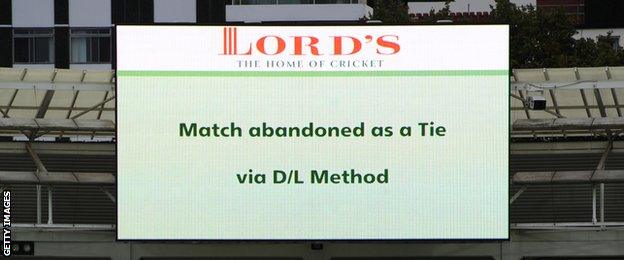Tony Lewis: Cricket statistician of the Duckworth-Lewis method dies aged 78
- Published

Tony Lewis (right) and Frank Duckworth received their MBEs in 2010 for services to mathematics and cricket
Tony Lewis, the mathematician and statistician who co-devised what became known as the Duckworth-Lewis method for settling weather-affected limited-overs matches, has died at the age of 78.
Lewis and fellow academic Frank Duckworth came together to produce a fairer method of settling such games than the controversial system which had been used at the 1992 World Cup.
Their new system was first used in 1997 for a Zimbabwe v England game, and officially adopted by the International Cricket Council in 1999.
Duckworth-Lewis calculates targets based on the batting team's remaining resources - wickets in hand, and overs in hand - via mathematical formulae.
In 2014, Australian professor Steven Stern became the custodian of the system, on the retirements of Duckworth and Lewis, and it is now known as the Duckworth-Lewis-Stern (DLS) method.
The England and Wales Cricket Board said in a statement: "Cricket is deeply indebted to both Tony and Frank's contributions to the sport. We send our sincere condolences to Tony's family."
Born in Bolton, Lewis was a lecturer at the University of the West of England when he and Duckworth came together after South Africa's target in the 1992 World Cup semi-final against England was comically reduced from 22 runs off 13 balls to 22 runs off one ball.
Duckworth explained in 2007: "I recall hearing Christopher Martin-Jenkins on radio saying 'surely someone, somewhere, could come up with something better' and I realised that it was a mathematical problem that required a mathematical solution."
Lewis and Duckworth were appointed MBEs in 2010.
Around the same time, an Irish pop group formed by Neil Hannon of The Divine Comedy and Thomas Walsh of Pugwash - calling themselves The Duckworth Lewis Method - released two cricket-themed concept albums in 2009 and 2013.

A rain-affected England v India one-day international at Lord's in 2011 finished as a tie after England matched, but failed to overtake, the Duckworth/Lewis par score when rain ended play